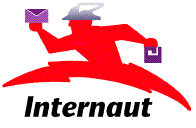
This is the promise of Cable data, which uses the cable TV connections to transmit digital data. Today the majority of cable operators offer some kind of data service, and several cable companies are planning to offer Cable Internet in the next year. Tests are currently being conducted in Cambridge, MA (Continental Cablevision and PSI), and in the Bay Area (Hybrid Networks along with TCI, Viacom, and Palo Alto Cable Co-op). Hybrid's service is now available in Cupertino, CA, and they are planning to expand service to the rest of the Bay Area in 1994, as well as eventually to offer service to cable users in Washington, DC, Los Angeles, Boston, and New York. Hybrid Networks was founded in 1990 with funding from its founders and venture capitalists, as well as help from a substantial R&D contract with ARPA.Their version of Cable Internet is known as the Hybrid Access System (HAS) IN channel service.
An alternative outgoing connection is needed because most cable service providers do not support upstream channels, and those that do usually must transmit over copper cable and can only provide 2-3 very noisy channels. Noise is a big problem for upstream channels operating over copper, since copper wire is much more susceptible to noise than fiber, and various types of noise (ingress, micro reflections, leakage, etc.) accumulate as the signal moves upstream toward the cable head. As a result, modems capable of operating over upstream cable channels are quite sophisticated and expensive, running approximately US$1,000. System upgrades such as adding upstream signal amplifiers, or rewiring with fiber optics, would allow cable operators to support two way data transmission, and some already have this capability. How quickly other cable operators follow suit depends on whether they feel they can justify the extra cost based on end-user demand.
When a BBS is hooked up to a cable Internet link, packets flow in to the BBS on the high bandwidth channel, but must flow out on the modem channel. The key to making this arrangement work is to ensure that your traffic levels match the capabilities of the link: much more data should flow in to the BBS than flows out.
For example, an IN channel link will not work well for allowing users to telnet in to a BBS. This is because when a user downloads, the data packets must flow out from the BBS over the modem link, while the user's acknowledgement packets will flow back in to the BBS. The result is that when more than one user attempts to download at a time, you will saturate the modem link, while leaving the high bandwidth cable link unused. A similar problem occurs if you try to set up your BBS as an FTP archive or a Gopher server.
However, users dialing in over modem will be able to retrieve a file from a remote site via FTP. In this case, the data packets from the remote site will flow in to the BBS over the cable link, while the packet acknowledgements will flow out from the BBS to the remote site over the modem link. The result is a good match to the bandwidth capabilities of the asymmetric channel. When the users download the retrieved file to their home machine, their packets will travel out over the phone line they dialed in on, not over the Internet hookup, so no bottlenecks will result. Allowing users to access remote Gopher and Archie servers is also ok.
Cable Internet is therefore a good match for the BBSNet package being readied by Murkworks, Inc. According to Brad Clements, "BBSNet supports Incoming/Outgoing telnet, FTP/Archie, and Gopher. BBSnet supports PCBoard (/M version required for incoming Telnet), The Major BBS (advanced LAN option required for incoming Telnet), WildCat!IM (Version 4 require for incoming Telnet), Searchlight, TurBoard and other Fossil compatible BBSes. If a BBS can run on top of a FOSSIL driver, it can support incoming Telnet, and if it can execute a DOS door, and provide a FOSSIL interface to your async port, it can support dial-up telnet, ftp/archie and gopher."







